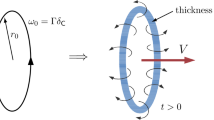Abstract
In 1960 Edward Lorenz (1917–2008) published a pioneering work on the ‘maximum simplification’ of the barotropic vorticity equation. He derived a coupled three-mode system and interpreted it as the minimum core of large-scale fluid mechanics on a ‘finite but unbounded’ domain. The model was obtained in a heuristic way, without giving a rigorous justification for the chosen selection of modes. In this paper, it is shown that one can legitimate Lorenz’ choice by using symmetry transformations of the spectral form of the vorticity equation. The Lorenz three-mode model arises as the final step in a hierarchy of models constructed via the component reduction by means of symmetries. In this sense, the Lorenz model is indeed the ‘maximum simplification’ of the vorticity equation.
Similar content being viewed by others
References
Anco, S.C., Bluman, G.: Direct construction method for conservation laws of partial differential equations. Part I: Examples of conservation law classifications. Eur. J. Appl. Math. 13, 545–566 (2002)
Anderson, I.M., Fels, M.E., Torre, C.G.: Group invariant solutions without transversality. Commun. Math. Phys. 212, 653–686 (2000)
Andreev, V.K., Rodionov, A.A., Group analysis of equations of planar flows of an ideal fluid in Lagrangian coordinates. Dokl. Akad. Nauk SSSR 298, 1358–1361 (1988)
Berker, R.: Intégration des équations du mouvement d’un fluide visqueux incompressible. In: Handbuch der Physik, vol. VIII/2, pp. 1–384. Springer, Berlin (1963)
Golubitsky, M., Stewart, I., Schaeffer, D.G.: Singularities and Groups in Bifurcation Theory, vol. II. Springer, New York (1985)
Head, A.K.: LIE, a PC program for Lie analysis of differential equations. Comput. Phys. Comm. 77, 241–248 (1993) See also http://www.cmst.csiro.au/LIE/LIE.htm
Lorenz, E.N.: Maximum simplification of the dynamic equations. Tellus 12, 243–254 (1960)
Olver, P.J.: Applications of Lie Groups to Differential Equations. Springer, New York (1993)
Ovsiannikov, L.V.: Group Analysis of Differential Equations. Academic Press, New York (1982)
Thiffeault, J.-L., Horton, W.: Energy-conserving truncations for convection with shear flow. Phys. Fluid 8, 1715–1719 (1996)
Author information
Authors and Affiliations
Corresponding author
Rights and permissions
About this article
Cite this article
Bihlo, A., Popovych, R.O. Symmetry justification of Lorenz’ maximum simplification. Nonlinear Dyn 61, 101–107 (2010). https://doi.org/10.1007/s11071-009-9634-5
Received:
Accepted:
Published:
Issue Date:
DOI: https://doi.org/10.1007/s11071-009-9634-5



